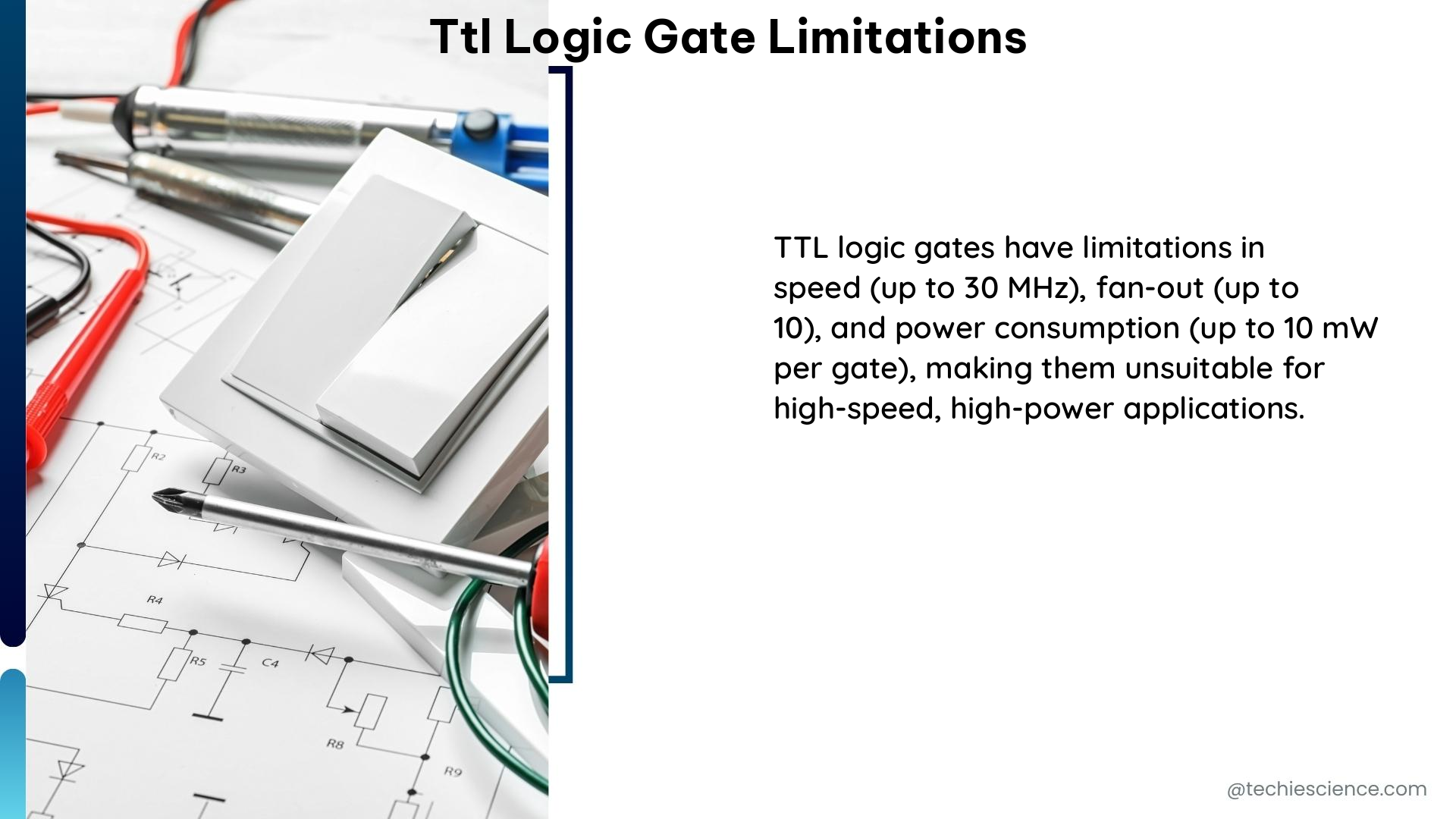TTL (Transistor-Transistor Logic) is a widely used digital logic family that has been a staple in electronic circuit design for decades. While TTL logic gates offer several advantages, they also have inherent limitations that designers must consider when working with these components. This comprehensive guide delves into the technical details and quantifiable aspects of TTL logic gate limitations, providing a valuable resource for electronics students and professionals.
Voltage Levels
One of the primary limitations of TTL logic gates is the strict voltage level requirements. TTL gates operate on a nominal power supply voltage of 5 volts, with a tolerance of ±0.25 volts. The acceptable input signal voltages for a low logic state range from 0 volts to 0.8 volts, while for a high logic state, they range from 2 volts to 5 volts.
The acceptable output signal voltages, which are guaranteed by the gate manufacturer over a specified range of load conditions, range from 0 volts to 0.5 volts for a low logic state and from 2.7 volts to 5 volts for a high logic state. These narrow voltage ranges can pose challenges when interfacing TTL logic gates with other digital logic families or when operating in noisy environments.
Current Characteristics

TTL logic gates have specific current requirements that must be considered. The maximum input-low current (I IL) is 1.11 mA, and the maximum input-high current (I IH) is 7.4 µA over the 0 to 70°C temperature range. These current values are crucial when designing input and output circuits to ensure proper operation and avoid exceeding the gate’s capabilities.
The low and high output characteristics of TTL gates can be determined by varying the load. The output current for a low logic state (I OL) can be as high as 16 mA, while the output current for a high logic state (I OH) is typically around 400 µA. Designers must ensure that the load connected to the TTL gate’s output does not exceed these current limits to prevent damage or improper operation.
Power Consumption
Compared to their CMOS counterparts, TTL logic gates consume substantially more power at rest. However, the power consumption of TTL devices does not increase with clock speed as rapidly as CMOS devices. This makes TTL logic gates more suitable for applications with higher clock frequencies, where power dissipation is a concern.
When compared to contemporary ECL (Emitter-Coupled Logic) circuits, TTL logic gates use less power and have easier design rules, but they are substantially slower. This trade-off between power consumption and speed is an important consideration when selecting the appropriate logic family for a specific application.
Noise Immunity
TTL logic gates have a relatively high output resistance at output logical “1” that is determined by the nature of the TTL output stage. This high output resistance provides at least 0.4 V of noise immunity, which helps to ensure reliable operation in the presence of electrical noise or interference.
The standardization of TTL voltage levels is a significant advantage, as it allows for the use of TTL chips from various manufacturers on the same circuit board. This compatibility ensures that complex circuit boards can be assembled using TTL components from different sources, selected based on availability and cost, without compromising functionality.
Additional Considerations
Beyond the primary limitations discussed above, there are a few other factors to consider when working with TTL logic gates:
-
Temperature Range: TTL logic gates are typically specified to operate within a temperature range of 0°C to 70°C. Exceeding this range can lead to performance degradation or even device failure.
-
Propagation Delay: TTL logic gates have a relatively high propagation delay, which can limit the maximum operating frequency of the circuit. The propagation delay is typically in the range of 10 to 30 nanoseconds, depending on the specific gate type and load conditions.
-
Fan-Out: The fan-out of a TTL logic gate, which is the number of inputs it can drive, is typically limited to 10 standard TTL inputs. Exceeding the fan-out can lead to improper operation or damage to the gate.
-
Capacitive Loading: The input capacitance of TTL logic gates is relatively high, typically in the range of 15 to 50 picofarads. This can limit the maximum operating frequency and the number of gates that can be driven by a single output.
-
Latch-Up: TTL logic gates are susceptible to latch-up, a condition where the internal transistors become stuck in a high-current state, potentially leading to device failure. Proper circuit design and power supply sequencing are essential to mitigate this issue.
By understanding these limitations and their quantifiable aspects, electronics designers can make informed decisions when selecting and implementing TTL logic gates in their circuits, ensuring reliable and efficient performance.
References
- EXPERIMENT 3: TTL AND CMOS CHARACTERISTICS
- Transistor–transistor logic – Wikipedia
- 14.1 Transistor-Transistor Logic (TTL)
- TTL Logic Gate Resistor Values – Electronics Stack Exchange
- Logic Signal Voltage Levels | Logic Gates | Electronics Textbook

The lambdageeks.com Core SME Team is a group of experienced subject matter experts from diverse scientific and technical fields including Physics, Chemistry, Technology,Electronics & Electrical Engineering, Automotive, Mechanical Engineering. Our team collaborates to create high-quality, well-researched articles on a wide range of science and technology topics for the lambdageeks.com website.
All Our Senior SME are having more than 7 Years of experience in the respective fields . They are either Working Industry Professionals or assocaited With different Universities. Refer Our Authors Page to get to know About our Core SMEs.